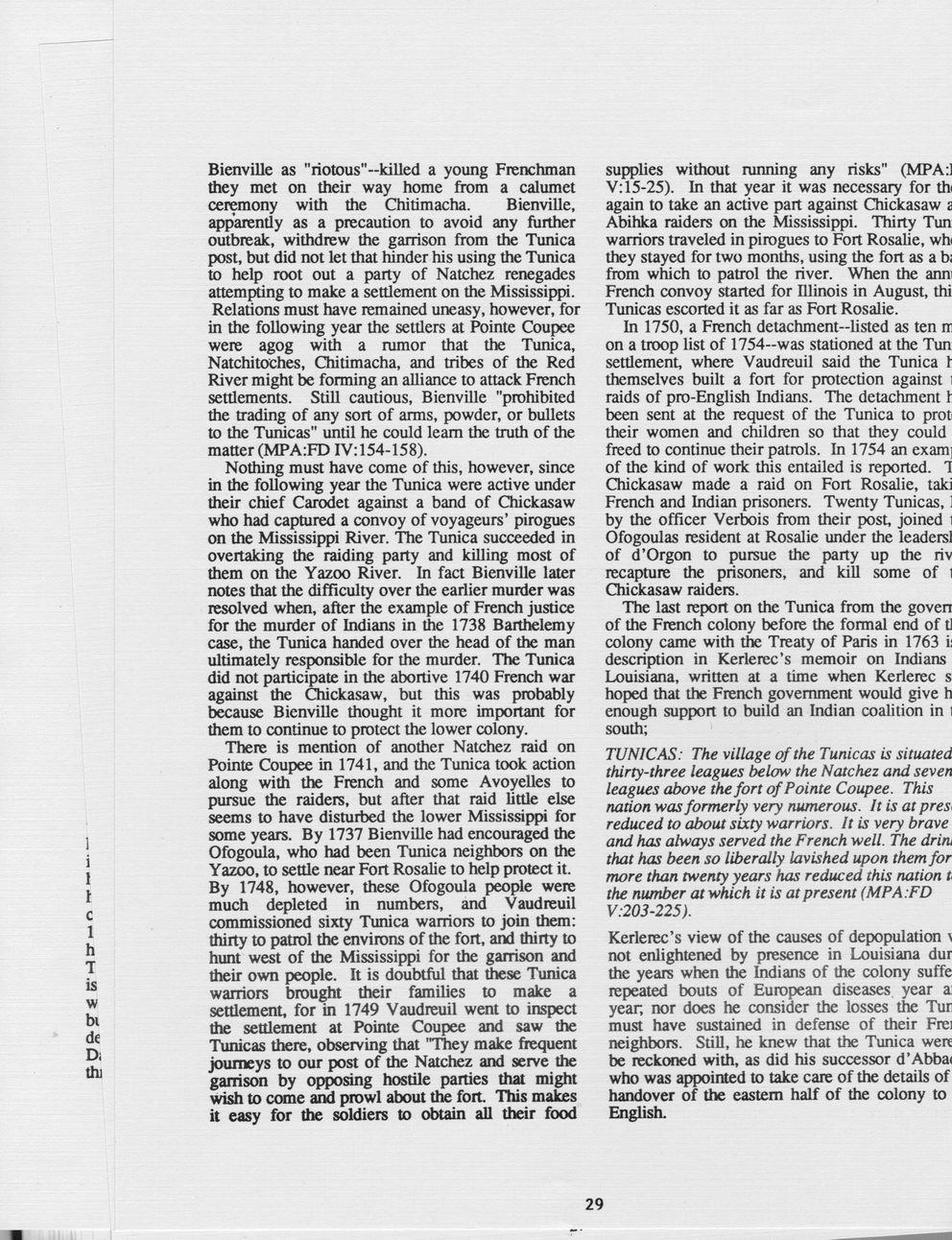This text was obtained via automated optical character recognition.
It has not been edited and may therefore contain several errors.
Bienville as "riotous"--killed a young Frenchman they met on their way home from a calumet ceremony with the Chitimacha. Bienville, apparently as a precaution to avoid any further outbreak, withdrew the garrison from the Tunica post, but did not let that hinder his using the Tunica to help root out a party of Natchez renegades attempting to make a settlement on the Mississippi. Relations must have remained uneasy, however, for in the following year the settlers at Pointe Coupee were agog with a rumor that the Tunica, Natchitoches, Chitimacha, and tribes of the Red River might be forming an alliance to attack French settlements. Still cautious, Bienville "prohibited the trading of any sort of arms, powder, or bullets to the Tunicas" until he could learn the truth of the matter (MPA:FD IV: 154-158). Nothing must have come of this, however, since in the following year the Tunica were active under their chief Carodet against a band of Chickasaw who had captured a convoy of voyageurs’ pirogues on the Mississippi River. The Tunica succeeded in overtaking the raiding party and killing most of them on the Yazoo River. In fact Bienville later notes that the difficulty over the earlier murder was resolved when, after the example of French justice for the murder of Indians in the 1738 Barthelemy case, the Tunica handed over the head of the man ultimately responsible for the murder. The Tunica did not participate in the abortive 1740 French war against the Chickasaw, but this was probably because Bienville thought it more important for them to continue to protect the lower colony. There is mention of another Natchez raid on Pointe Coupee in 1741, and the Tunica took action along with the French and some Avoyelles to pursue the raiders, but after that raid little else seems to have disturbed the lower Mississippi for some years. By 1737 Bienville had encouraged the Ofogoula, who had been Tunica neighbors on the Yazoo, to settle near Fort Rosalie to help protect it. By 1748, however, these Ofogoula people were much depleted in numbers, and Vaudreuil commissioned sixty Tunica warriors to join them: thirty to patrol the environs of the fort, and thirty to hunt west of the Mississippi for the garrison and their own people. It is doubtful that these Tunica warriors brought their families to make a settlement, for in 1749 Vaudreuil went to inspect the settlement at Pointe Coupee and saw the Tunicas there, observing that "They make frequent journeys to our post of the Natchez and serve the garrison by opposing hostile parties that might wish to come and prowl about the fort. This makes it easy for the soldiers to obtain all their food supplies without running any risks" (MPA:1 V: 15-25). In that year it was necessary for th< again to take an active part against Chickasaw s Abihka raiders on the Mississippi. Thirty Tun warriors traveled in pirogues to Fort Rosalie, whi they stayed for two months, using the fort as a b; from which to patrol the river. When the ann French convoy started for Illinois in August, thi Tunicas escorted it as far as Fort Rosalie. In 1750, a French detachment-listed as ten rr on a troop list of 1754-was stationed at the Tun settlement, where Vaudreuil said the Tunica 1 themselves built a fort for protection against l raids of pro-English Indians. The detachment 1 been sent at the request of the Tunica to prot their women and children so that they could freed to continue their patrols. In 1754 an exam] of the kind of work this entailed is reported. 1 Chickasaw made a raid on Fort Rosalie, taki French and Indian prisoners. Twenty Tunicas, ] by the officer Verbois from their post, joined 1 Ofogoulas resident at Rosalie under the leadersl of d’Orgon to pursue the party up the riv recapture the prisoners, and kill some of I Chickasaw raiders. The last report on the Tunica from the goverr of the French colony before the formal end of tl colony came with the Treaty of Paris in 1763 i: description in Kerlerec’s memoir on Indians Louisiana, written at a time when Kerlerec s hoped that the French government would give h enough support to build an Indian coalition in I south; TUNICAS: The village of the Tunicas is situated thirty-three leagues below the Natchez and seven leagues above the fort of Pointe Coupee. This nation was formerly very numerous. It is at pres reduced to about sixty warriors. It is very brave and has always served the French well. The drin that has been so liberally lavished upon them for more than twenty years has reduced this nation t the number at which it is at present (MPA. FD V .203-225). Kerlerec’s view of the causes of depopulation \ not enlightened by presence in Louisiana dur the years when the Indians of the colony suffe repeated bouts of European diseases year a year, nor does he consider the losses the Tun must have sustained in defense of their Frei neighbors. Still, he knew that the Tunica were be reckoned with, as did his successor d’Abba* who was appointed to take care of the details of handover of the eastern half of the colony to English.

Native Americans The-Tunica-Biloxi-Tribe-its-Culture-and-People-(37)